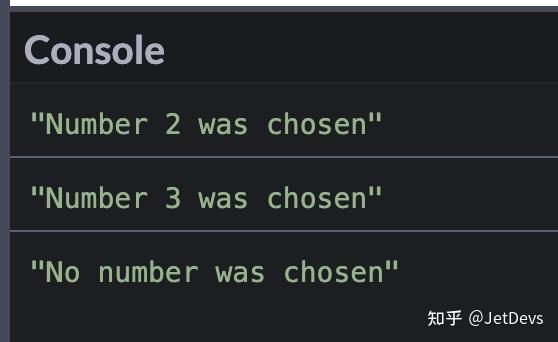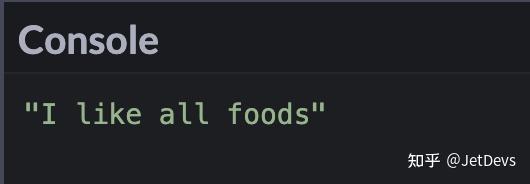JavaScript Switch 案例 – JS Switch 语句示例
在JavaScript中,有时您可以考虑使用switch语句,而不是if else语句。
switch语句可以比复杂的if else语句具有更干净的语法。
看看下面的例子——你可以选择使用更容易阅读的 switch 语句,而不是使用这个长长的 if else 语句。
const pet = "dog";
if (pet === "lizard") {
console.log("I own a lizard");
} else if (pet === "dog") {
console.log("I own a dog");
} else if (pet === "cat") {
console.log("I own a cat");
} else if (pet === "snake") {
console.log("I own a snake");
} else if (pet === "parrot") {
console.log("I own a parrot");
} else {
console.log("I don't own a pet");
}
const pet = "dog";
switch (pet) {
case "lizard":
console.log("I own a lizard");
break;
case "dog":
console.log("I own a dog");
break;
case "cat":
console.log("I own a cat");
break;
case "snake":
console.log("I own a snake");
break;
case "parrot":
console.log("I own a parrot");
break;
default:
console.log("I don't own a pet");
break;
}在本文中,我将解释什么是切换语句以及它们的工作原理。我还将帮助您确定它们是否是代码中使用的好选项。
什么是switch陈述?
在编程中,switch语句是一种控制流语句,用于根据多个情况测试expression的值。
这是switch语句的基本语法:
switch (expression) {
case 1:
//this code will execute if the case matches the expression
break;
case 2:
//this code will execute if the case matches the expression
break;
case 3:
//this code will execute if the case matches the expression
break;
default:
//this code will execute if none of the cases match the expression
break;
}计算机将检查switch语句,并检查case和expression之间是否严格等同===。如果其中一个案例与expression匹配,则该案case句中的代码将执行。
switch (expression) {
case 1:
//this code will execute if the case matches the expression
break;
case 2:
//this code will execute if the case matches the expression
break;
}如果所有情况都与表达式不匹配,则将执行default子句。
default:
//this code will execute if none of the cases match the expression
break;如果多个案例与switch语句匹配,则将使用与expression匹配的第一个case。
breakcase匹配时,语句将从switch中中断。如果不存在break语句,那么即使找到匹配项,计算机也会继续通过switch语句。
如果switch中存在return语句,那么您不需要break语句。
JavaScript中的switch语句示例
在本例中,我们正在将"oboe"与案例进行比较。"oboe"将与第三个case条款匹配,并将打印到控制台“I play the oboe”。
switch ("oboe") {
case "trumpet":
console.log("I play the trumpet");
break;
case "flute":
console.log("I play the flute");
break;
case "oboe":
console.log("I play the oboe");
break;
default:
console.log("I don't play an instrument. Sorry");
break;
}如果我将表达式更改为"no instrument"那么default子句将执行,打印到控制台的消息将是“I don't play an instrument. Sorry”
switch ("no instrument") {
case "trumpet":
console.log("I play the trumpet");
break;
case "flute":
console.log("I play the flute");
break;
case "oboe":
console.log("I play the oboe");
break;
default:
console.log("I don't play an instrument. Sorry");
break;
}缺少break语句
在本例中,匹配将是case2。但如果没有break语句,计算机将继续进入case3和default子句。
你应该看到三个 console.log 语句,因为break 语句没有被包含在内。
switch (2) {
case 1:
console.log("Number 1 was chosen");
case 2:
console.log("Number 2 was chosen");
case 3:
console.log("Number 3 was chosen");
default:
console.log("No number was chosen");
}
默认条款的位置
标准惯例是将default作为最后条款。但您也可以将它置于其他案例之前。
const food = "nuts";
switch (food) {
case "cake":
console.log("I like cake");
break;
case "pizza":
console.log("I like pizza");
break;
default:
console.log("I like all foods");
break;
case "ice cream":
console.log("I like ice cream");
break;
}
电脑仍会检查每个案例并找到匹配项。由于可变food与任何情况都不匹配,因此将执行default情况。
一次操作的多个案例
有时,您可能会有一个操作,对多个案例来说是相同的。
我们可以省略break语句,并在一组案例后放置一个单一操作,而不是为每个案例写出相同的 console.log。
语句 "This country is in Europe." 将被打印在控制台, 如果 country 匹配下列任一个单词 "France", "Spain", "Ireland" or "Poland".
const country = "Ireland";
switch (country) {
case "France":
case "Spain":
case "Ireland":
case "Poland":
console.log("This country is in Europe.");
break;
case "United States":
default:
console.log("This country is not in Europe.");
}阻止范围和switch语句
此示例将产生错误消息,因为message变量已声明,并且您不能在同一块范围内拥有相同的变量名称。
const errand = "Going Shopping";
switch (errand) {
case "Going to the Dentist":
let message = "I hate going to the dentist";
console.log(message);
break;
case "Going Shopping":
let message = "I love to shop";
console.log(message);
break;
default:
console.log("No errands");
break;
}
为了消除错误消息,需要将案例包裹在一组花括号中。
const errand = "Going Shopping";
switch (errand) {
case "Going to the Dentist": {
let message = "I hate going to the dentist";
console.log(message);
break;
}
case "Going Shopping": {
let message = "I love to shop";
console.log(message);
break;
}
default: {
console.log("No errand");
break;
}
}
总结
使用switch语句可以替代if else语句。switch语句将expression的值与多个情况进行比较。
switch声明将检查严格平等。在这个例子中,自"2"!== 2,default子句将执行。
switch (2) {
case "2":
console.log("Number 2 in a string");
break;
case "3":
console.log("Number 3 in a string");
break;
default:
console.log("Number not present");
break;
}breakcase匹配时,语句将从switch中中断。如果不存在break语句,那么即使找到匹配项,计算机也会继续通过switch语句。
*关注公众号填写问卷赢大奖*JetDevs上线好礼送不停
我们即将上线一个新的App,集社交、学习、找工作于一体的开发者生态社区
想要了解大家在开发中遇到的问题,邀您完成JetDevs开发者问卷
http://survey.jetdevs.com/?c=ZH10
此次问卷完成后更有幸运大抽奖活动哦!
参与必中~(最低1元)!
【JetDevs】
关注我们,了解更多关于开发者的相关资讯与100000开发者共同成长

